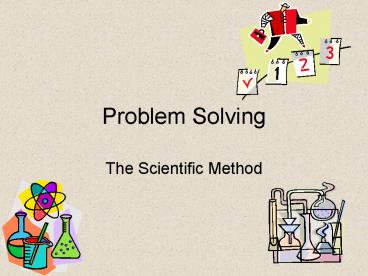Problem Solving - PowerPoint PPT Presentation
1 / 14
Title:
Problem Solving
Description:
Isaac Newton often referred to as 'father of modern day science' ... Sir Isaac Newton. Copernicus. A hypothesis can be described as. An answer. A wild guess ... – PowerPoint PPT presentation
Number of Views:529
Avg rating:3.0/5.0
Title: Problem Solving
1
Problem Solving
- The Scientific Method
2
The scientific method utilizes a pattern or
set of steps to solve problems.
- Observe.
- Ask a question or identify the problem.
- Make more observations.
- Form a hypothesis.
- Test hypothesis or experiment.
- Record and study data.
- Form a conclusion.
3
Scientific revolution and the scientific method.
- Revolution began with Nicholas Copernicus
- Galileo built first telescope able to check
out his own theories and prove some of them.
First to use the scientific method. - Isaac Newton often referred to as father of
modern day science - Based his theories on observations of natural
phenomena. (means observable facts or events)
4
Putting it all together
- Scientists talk about having a protocol for an
experiment. Protocol is another word for plan. - Experiments have to be repeated many times to see
if the same result is obtained each time. Having
a set method or protocol will ensure the
experiment is repeated the same each time.
5
Hypotheses lead to predictions.
- A hypothesis is a possible answer to a scientific
question. In your conclusion you must state that
your hypothesis was proven or rejected. - If the hypothesis is supported after several
tests, then the hypothesis becomes a theory. - Remember, a theory is the best explanation that
scientists have to explain things they have
observed. It is not a proven fact.
6
Experiments test hypotheses.
- The experiment is the most exciting part of the
scientific method. - The test of a hypothesis is called an experiment.
- The condition that is tested is known as the
variable. - The control is the basis for the comparison.
- This is part of the experiment that stays the
same. - The things that remain the same are the
constants. - While testing you collect data from your
experiment. - The conclusion reports the results of the
experiment and states whether or not the
hypothesis still seems reasonable,
7
Some questions to answer
- List the seven steps of the scientific method.
- Observe.
- Ask a question or identify the problem.
- Make more observations.
- Form a hypothesis.
- Test hypothesis or experiment.
- Record and study data.
- Form a conclusion.
8
Who built a telescope in 1609 and used the
scientific method?
- Galileo
- Sir Isaac Newton
- Copernicus
9
A hypothesis can be described as
- An answer
- A wild guess
- A prediction
10
What is a theory?
- a theory is the best explanation that scientists
have to explain things they have observed. It is
not a proven fact.
11
A variable is
- kind of hypothesis
- Any factor that can change in an experiment
12
- You cant perform an experiment without a
microscope/control. - control
13
- In a given experiment how many variables should
you change? - one
14
- When a scientists finishes an experiment, he or
she writes up a formal _________. - conclusion































